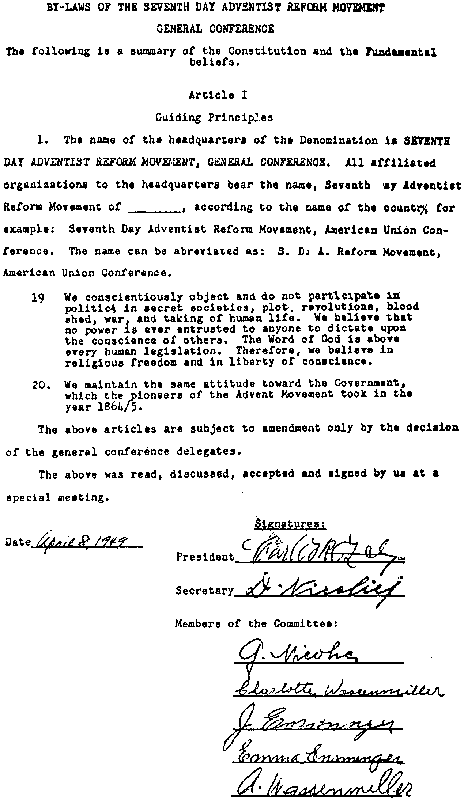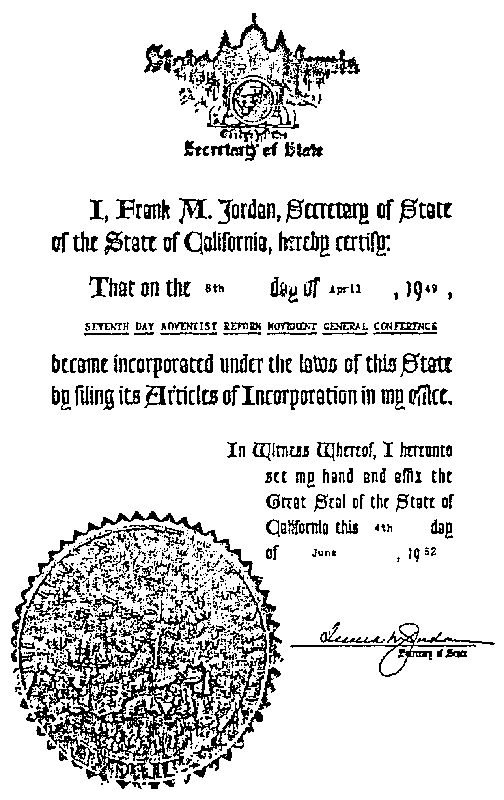After the disagreement of May 1951, we thought that the election of two separate General Conference Committees, under the same name, within the same corporation, would be regarded as only a temporary measure until the convening of a new delegation session, with a legal majority of representatives of the membership from both sides, for a joint election of only one General Conference Committee, as required by principle (Testimonies, vol. 8, p. 237). But the leaders of the separated brethren did not take that for granted. They decided that their decisions and actions, though one-sided and based on a minority of the membership, were to be definite and irrevocable, regardless of the principle which says that "the entire body of believers," through its legally appointed delegates "from all parts of the earth" (The Acts of the Apostles, p. 96; Testimonies, vol. 9, p. 261), is the voice of God, the highest authority on earth.
 |
| General Conference headquarters of the SDA Reform Movement, Sacramento, California, USA (1949-1969). |
Therefore, the impasse between the two parties has hinged on the following question which we have often put to the leaders of those brethren: Do you agree that all the Unions and Fields together, through their legally elected representatives, respecting the principle of equal rights and duties (Matthew 7:12; Thoughts From the Mount of Blessing, pp. 134–137), have had authority, from the beginning of the crisis, to revise and correct the decisions and actions of the divided leaders (both sides) who could not come to an agreement in 1951? Or do you expect us to recognize as final authority the unilateral resolutions and actions of those leaders (Brethren Kozel, Mueller, and their supporters and successors) who could not see the need to "labor in harmony with the decisions arrived at by the general body of believers in united council" (The Acts of the Apostles, p. 199)?
 |
| Constitution, Bylaws, and Fundamental Beliefs of the SDA Reform Movement General Conference (beginning of first page and end of last page), signed April 8, 1949. |
 |
| Certificate of Incorporation of the SDA Reform Movement General Conference, April 8, 1949, issued by the state of California, USA. |
The fact that the first alternative has been rejected, as if our Unions and Fields had no voice in the solution of the crisis, and that the second alternative has been maintained since May 1951, is the reason why, until now, there has been no solution to the impasse.
However, we have not remained indifferent toward our separated brethren. Again and again we assured them that we still love them and that we are seriously interested in a genuine reconciliation and reunification on the basis of the truth, and in the way ordained of the Lord, namely, through a joint election of the General Conference officers (Testimonies, vol. 8, p. 237), at a legal General Conference delegation session. Dating from October 10, 1951, our position was made clear to them, repeatedly, as follows:
The highest authority of God on earth–an assembly of legally elected representatives from all the Unions and Fields (both sides together)–should examine the facts that caused the division for which both sides blame each other and withdraw the "thorns" from the "wound." Corrections must be made wherever needed. Right principles must be restored and wrong principles must be discarded.
Since the great shaking (1948–1952), which was deplored by some and applauded by others, it has been our great concern to restore fundamental principles which belong to the people of God, such as: the moral integrity of the ministry, which had been unfortunately neglected for years before 1951; the unity of the faith (if anyone advocates divorce and remarriage, for example, he cannot occupy a position in the leadership); the true concept of "General Conference" and the authority of the church (according to Principles of Faith, part III, section D; Testimonies, vol. 9, p. 26, and vol. 3, p. 451; The Acts of the Apostles, pp. 96, 199, 200; Testimonies, vol. 4, p. 16); the golden rule (Matthew 7:12; Thoughts from the Mount of Blessing, pp. 134–137; The Desire of Ages, p. 414; Sketches from the Life of Paul, p. 69); elimination of all traces of authoritarianism or Romanism (Testimonies to Ministers, pp. 361, 362).
By the help of God, we obtained specific answers to these questions: Do delegates have authority to disfellowship delegates from the church at a General Conference session (The Desire of Ages, pp. 441, 805, 806;Testimonies, vol. 7, pp. 263, 264; Early Writings, p. 100)? Do a few delegates, representing only a small minority of the membership, have authority to form an exclusive group and organize themselves separately by refusing a joint reorganization (Testimonies, vol. 8, p. 237; Selected Messages, bk. 2, p. 374)? When there is a serious disagreement at the General Conference level, do a few leaders have authority to refuse to submit the problem to the legal authority of the church by refusing to listen to the voice of the whole body of believers in a general assembly of representatives (The Acts of the Apostles, pp. 96, 199, 200; Testimonies, vol. 9, p. 261) and bring the matter before a worldly court (Christ’s Object Lessons, pp. 248, 249; Manuscript Releases, vol. 5, pp. 296, 413, 415, 418; Special Testimonies, Series B, No. 7, p. 27)? These are some of the controversial issues which also involve principles and which lie at the cause of the division.
The leadership of the separated brethren, also, defined their position on the basis of Brother Kozel’s letter of March 16, 1955, in answer to our renewed appeal for a settlement of the impasse:
"If they want peace, then there is only one way: They must dissolve their General Conference and their churches; give back to us the properties that they have stolen; and send back to our churches the honest members who are imbued with a spirit of sincere repentance. Then, after a long period of probation, they may be accepted back into the church, but without offices. Of course, they will not go this way of humiliation through the desert."
This stand has been taken by the leaders of the separated brethren, officially, from the very beginning of the crisis, when both sides still formed one and the same denomination, when they still professed to belong to one and the same corporation together with us (agreement signed May 7, 1952). Although the majority of their most responsible leaders have confirmed this position again and again, even in writing, some of their leaders have admitted to us their disappointment. They can see that this attitude does not have the approval of God, who warned us through His servant:
"Is the president of the General Conference to be the god of the people? . . . The Lord has a controversy with His people over this matter. Why have they left the Lord their God . . . ? Just as soon as man is placed where God should be . . . his powers become unsanctified and perverted. He feels competent to judge his fellowmen, and he strives unlawfully to be a god over them. . . . Men, saved only by the atoning sacrifice of Christ Jesus, have no right to seek to exalt themselves above their fellowmen."–Testimonies to Ministers, pp. 375–378.
"To no man has been appointed the work of being a ruler over his fellowmen."–Ibid., p. 495. Read also pp. 279, 280.
"That which makes me feel to the very depths of my being, and makes me know that their works are not the works of God, is that they [finite men] suppose they have authority to rule their fellowmen. The Lord has given them no more right to rule others than He has given others to rule them. Those who assume the control of their fellowmen take into their finite hands a work that devolves upon God alone."– Ibid., p. 76.
The spirit which engendered this type of difficulties in the Reform Movement did not begin its work in 1951; it existed much earlier. The leaders of the American Union (Brethren Welp, Doerschler, Kramer) were the first to denounce this form of "corruption" (this is the term that they used) in their letters and circular letters (from the second half of 1948 to the beginning of 1952). This strange spirit was gaining ground much earlier, in the Seventh-day Adventist Church, when God used His servant to sound the alarm: "The General Conference is itself becoming corrupted with wrong sentiments and principles. . . . Common fire has been used in place of the sacred. . . . Men have taken unfair advantage of those whom they supposed to be under their jurisdiction. They were dertermined to bring the individuals to their terms; they would rule or ruin. . . . The highhanded power that has been developed, as though position has made men gods, makes me afraid. . . . It is a curse wherever and by whomsoever it is exercised."– Ibid., pp. 359–361.
Since the beginning of the great shaking, we have realized that we were not the only ones who were struggling to see strange principles discarded and holy principles restored. And today (1996) we are more hopeful than ever, because many of the separated brethren, with whom we stand on good terms, assure us that they, too, are doing their part. Sooner or later, the honest and faithful SDA Reformers from both sides, who have the principles of Christ’s kingdom restored in their hearts, together with all other sincere and reform-minded Adventists, who are also lifting up the standards of truth, will be united in one fold (John 10:16).